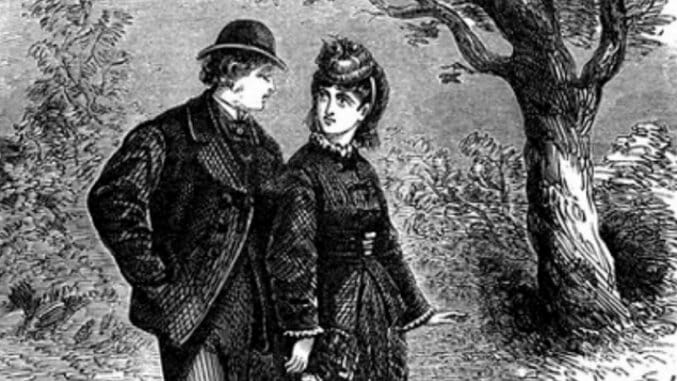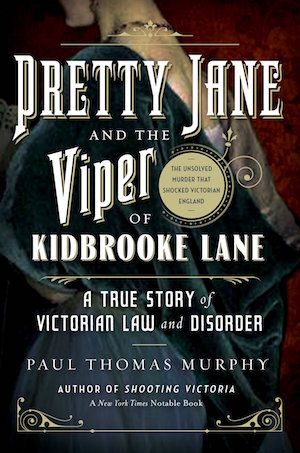Pretty Jane and the Viper of Kidbrooke Lane by Paul Thomas Murphy
Illustration depicting Jane Clouson and her murderer courtesy of the British Library. Books Reviews
On a spring night in south London, a young woman is found brutally disfigured and near death. That’s where Paul Thomas Murphy’s latest, Pretty Jane and the Viper of Kidbrooke Lane, begins. But while Murphy calls it a crime that shocked Victorian England, the story of maid Jane Maria Clouson’s death is less shocking than completely expected. It’s a story of a young woman who lived her life in service, was murdered by someone who was never held accountable and has largely been forgotten in history books.
Clouson’s murder took place in April, 1871, on London’s secluded Kidbrooke Lane. The crime itself was gruesome; she was beaten with a hammer, but her injuries did not immediately kill her. Instead, she clung to life long enough to get the attention of a policeman and then slipped into a five-day coma before dying. She was a Jane Doe until her family came forward to identify her body, facilitating her growing image as a martyr for the working class.
 But most of Murphy’s book isn’t truly about Clouson. Pretty Jane is far more focused on the investigation and the ensuing trial of Edmund Pook, the son of Clouson’s former employer. The authorities relied on poor evidence and weak witness accounts to show that Pook bought the hammer used to kill Clouson and to place him in the nearby area around the time of her death. But by the time the verdict of not guilty was handed down, it was clear that they didn’t have much of a case. In fact, the case remains unsolved.
But most of Murphy’s book isn’t truly about Clouson. Pretty Jane is far more focused on the investigation and the ensuing trial of Edmund Pook, the son of Clouson’s former employer. The authorities relied on poor evidence and weak witness accounts to show that Pook bought the hammer used to kill Clouson and to place him in the nearby area around the time of her death. But by the time the verdict of not guilty was handed down, it was clear that they didn’t have much of a case. In fact, the case remains unsolved.
As anyone who watches police procedurals can attest, the most interesting parts of the story are rarely in the courtroom. This damper of bureaucracy and minutiae is only exacerbated by Pretty Jane’s Victorian setting; though Murphy shows that it was high energy and that tempers flared more than once, the language of the time fails to reflect that emotion. The rotating cast of witnesses, prosecutors and experts is increasingly difficult to track, making it nearly impossible to recall what information is in play during the trial. There’s simply no sense of danger in Murphy’s occasionally academic prose.
Murphy does touch on fascinating dynamics from the era, including class divisions and the privileges that served as signs of these differences. The idea that Clouson was “dirty” comes up several times, first used a pejorative by the Pook family and rebuked by everyone who knew her. But without adequate context to make the true meaning of such an insult clear, it reads like semantical bickering. Instances like this make it clear that while Murphy is familiar with the nuances and norms of Victorian England, he fails to communicate a broader context to the reader.
Given the era in which the murder took place, this is a particularly disappointing failure. Victorian England was a captivating place littered with extreme juxtapositions. The gaslit haze of the time brings immediately to mind the perfect setting for a grisly crime, even as the still repressive expectations that governed society make it seem like a more civilized era. To skim past the fact that this was the period of upward mobility and penny dreadfuls—a time that redefined the relationship between people and work, giving rise to leisure that relied heavily on the macabre and morbid—leaves out what could have made the story truly engaging.
Murphy seems convinced that Pook did commit the murder, but the record doesn’t back him up. Much like the investigators almost 150 years ago, Murphy fails to make a strong case. When at the end of the book he writes, “Jane Clouson mattered,” it seems like a scramble to connect the vicious death to the bulk of the book’s focus, which was primarily on the men Jane served and who may have killed her. In Pretty Jane, the titular character is little more than a sidebar in the story.